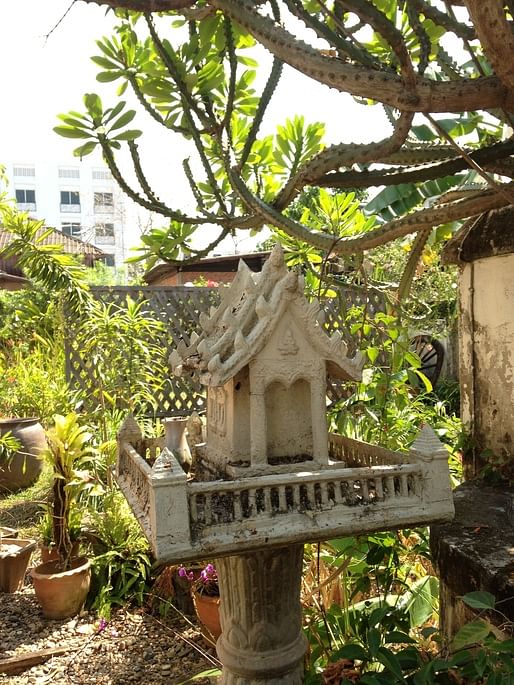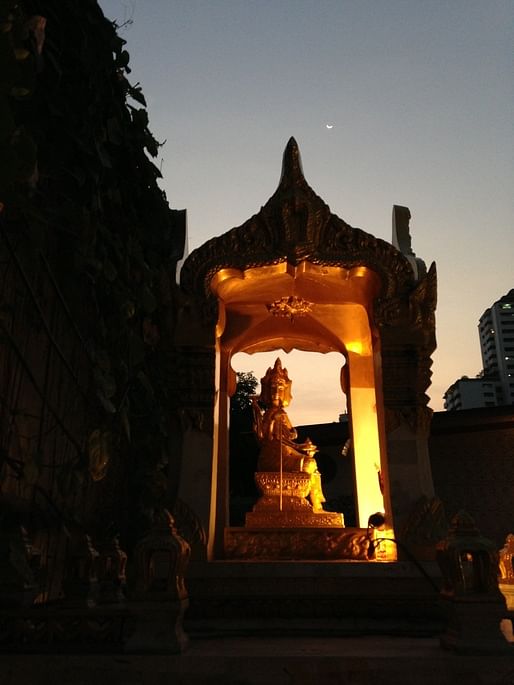

The end of the ride. Hanoi, Vietnam
1200 miles. 2 months. 3 countries. 1 broken wheel. 1 broken rack. 1 broken fender. 5 or 6 broken spokes. 0 flats. Seriously, 0 flats. Our journey took us from Chiang Mai, Thailand, through Laos, and up to Hanoi, Vietnam. I’ve now parted with my riding partner and headed back to Thailand to chart a new velocity towards different challenges. My current adventure is at Din Dang Natural Building Center, where I’m learning clay brick making in the small Thai village of Paksong, Phato District.

Making clay bricks at Din Dang.
I’m still digesting so much of our adventure, it seemed to come and go so quickly, even through feeling every crank rotation and road undulation. That sense, feeling each contour and movement, is an inherent reality of the act of cycling. There’s something about the speed of a bicycle that’s like the tuning of an instrument. It’s just… right. It’s a fast enough speed to maximize your energy and fast enough to get a sense of the form of the land. At a slower walking pace, these subtle shifts might not be perceptible until the roads really begin to incline. But it’s still slow enough to participate in the environment. Still slow enough to register your surroundings and see life in process. Match the speed with the physical repetition, rotation of wheels, cranks, feet, legs, and you find that you are riding on the ultimate thinking machine. With the body distracted, the mind gains freedom. Einstein famously said he figured out the Theory of Relativity while riding his bike.

This perfect tuning makes the bicycle a powerful instrument in site exploration, analysis, and interpretation. Grade changes feel a little different in the desk chair than in the saddle-- and not just the physical exertion, but the deep knowledge of continuity in the land. If only urban planners designed from their bike seats! Learning how to overcome the challenges of mountains, and the highs of enjoying the ride down is admittedly an acquired taste-- it took me a few weeks of all-day riding to really start enjoying them-- but it imparts an appreciation for the lay of the land. You want to exist within it, not subjugate it to whim. Other environmental conditions, especially climate: heat, windspeed, humidity, all take on new meaning when you are living, pedaling, within them. There is opportunity for rolling a rich understanding of accessibility design and pedestrian scale as well. I don’t pretend that these are all entirely novel lessons, but they feel easily forgotten.

In tune. Laos
But even more fundamentally, the cycling experience speaks to developing a certain sense of mindfulness. Distance cycling is a form of passive meditation, both excitement and boredom, action and thought. There’s an interplay of person and place. And, if that place happens to be Southeast Asia, it’s impossible not to notice the shrines. They’re everywhere. Thailand, Laos, Vietnam. On driveways, street corners, next to restaurants, in yards, in hotel lobbies. Everywhere. These shrines are spirit houses. Their placement is designated by brahmans to provide appeasing homes for local spirits. People adorn the houses with incense, candles, juice, soda, fruit, money, and other offerings. According to Bangkok.com, “In Bangkok urban planning sees influential spirits, not tenants getting the most prominent spots. A priest's advice may even lead to the architect's designs being altered.” This may or may not be apocryphal, but what an amazing scenario if it isn’t!

Spirit House for a Future Home. Laos
So, foregoing for the moment the specific intent of the spirit house, what’s the contemporary value of erecting shrines pervasively throughout the landscape? In bicycle touring, the meaning comes in large part from having a destination to reach, but if the only goal was to arrive at the destination, there are far more expedient means. So the process has as much or even more value than the destination itself. One has to explore the limits of one’s body and mind, not just the realities of the physical landscape. It is an endeavor of intent. Of design. Of mindfulness. Erecting a spirit house is also an intentional action, rife with ceremonial narrative, regular ritual, and mythological value. Like the perpetual cadence of the bicycle, the regular interval of the spirit house is a reminder for mindfulness, even meaning, embedded directly within the environment. Don’t these interactive (un)design landmarks shape the way we think throughout the day? They certainly affect how we design: we have to make room for something “bigger,” for something *other*, than ourselves.

Garden Spirit House. Vientiane, Laos
There is the potential problem of ubiquity though. These spirit houses are seemingly everywhere you look, and all very nearly identical (are they the Eastern equivalent of the suburban gazebo? God I hope not!) Does their pervasiveness desensitize us to their latent value? How many are too many? If they are all different, we might not recognize them with the same precision. Would you recognize a fire truck as quickly if it were blue? Maybe their uniformity and ubiquity are also an essential aspect of their value.

Spirit House and Moon. Bangkok, Thailand
In the modern Western landscape, meaning and mindfulness come from the wilderness… the entering into it, the taming of it, the conquering of it, the escaping from it, and escaping to it. Our literary and philosophical heritage have given it an ego, shaped it into an “other,” separate from society, and especially the city. But the critical operatives within landscape architectural theory and construction have challenged this staid understanding with projects that intertwine the biological, experiential, and infrastructural. So have action-minded citizens. Those exploring contemporary urban homesteading have embarked on maybe the most intentional form of urban living we have yet experimented with (society and urban aesthetics have changed so much since New Deal victory garden days-- noise ordinances, food safety regulations, planning codes, etc…).

Traffic-Protected Spirit House. Bangkok, Thailand.
These projects and processes are redefining our relationship with nature in the urban realm, but we are not yet shifting our perceptions looking the other direction, towards wilderness and nature itself. The great mythologist, Joseph Campbell, tells us that, “Life is without meaning.” And though in the Western tradition, we look to it for meaning, nature actually proves this to be true. Another Western convention of the environment as pervasive as “wilderness,” is the image of “Mother Earth.” That there is a benevolent… something, that has bequeathed us this magnificent beauty and bounty. But this “Mother” doesn’t care if we, as individuals, or even a species, lives or dies. “She” wouldn’t mind if the fox or the deer went extinct or if the temperature goes up or down. The Earth seeks only equilibrium (Which is why climate change is a human problem, not an earth problem. The Earth doesn’t need saving, we will).

Hotel Lobby Spirit House. Ha Long Bay, Vietnam.
“Life is without meaning,” Joseph Campbell says. “You bring the meaning to it.” In a meaningless world, the importance of living with intent is essential. Embedding imbued landmarks in the landscape is a potentially powerful marker for regular mindfulness. I am not suggesting the West needs to build spirit houses throughout our cities, but how do the buildings, infrastructure, and spaces we have already built or will come to build evoke reminders for daily mindfulness? We have those tacky church billboards with their bible quotes, but this is not even close to the solution. Even worthwhile messages loose their value in this institutional presentation, leading tangentially back to the ubiquity problem. We need solutions that are far more subtle and universal. As a landscape architect, I see my palette as more time and space than brick and mortar (though obviously they are inseparable), so as an action, not an object, I’m inclined to favor cycling and homesteading, but these are clearly not the solutions for many people.
I guess that brings us back to the beginning. Where are our markers for mindfulness in the Western urban landscape?
Living measures across the landscapes of Earth, rolling along the asphalt incision of world wilderness. Exploring the diversity of global urbanism from the ground. An intimately personal inquiry of lifestyle and limits, architecture and agriculture, organization and entropy, climate and cosmos. Point of embarcation: Los Angeles, California. First Destination: Chiang Mai, Thailand. Final Destination: Unknown. "I have no special talent, I am only passionately curious." _Einstein
4 Comments
Do you think our Western culture has become too splintered, diversified, for a singular marker for mindfulness? If you look within communities or subcultures, in which the people share a set of values that can be referenced, you may find such markers. But could there ever be something of that nature for a city such as Los Angeles? It's a great question Matt. (Maybe it is the fire trucks and ambulances -- who doesn't take a moment to pause and reflect on their existence when one wails past?)
Jana- Good point about the fire trucks! But do you really think people reflect... or just get annoyed about pulling over? But Mobile Mindfulness Markers are great. How fitting for Los Angeles!
In America at least, I see our culture as inherently diversified. But mindfulness is universal. It's prevalence is a reflection of the culture, but it's triggers and effects can easily transcend it. I'm sure there are subcultures and (specifically, religious) communities with easily identifiable markers (church building crosses come to mind). But religious, and even subcultural, symbols are tailored to specific groups of people to stimulate specific thoughts or emotions. Maybe there's value in these symbols as an aggregate lexicon, but that requires an increasingly cross-pollinated cultural literacy. Does that then make homogenization a greater threat than ubiquity?
Very insightful. One of the best arguments I've ever heard for riding a bicycle. You must be the brains of the operation. You can stay at my spirit house any day, buddy.
Although I may not be coming up with the next Theory of Relativity, I do feel like bicycling does have this Goldilocksian quality that allows for perfect perceptual intake. Moving at 70 mph, you will miss the details, but walking at a snail's pace may let you encounter too many. Maybe with the medium of a bicycle, we see just enough to ascribe the meaning we need to the environment around us. (The stationary ones at the gym don't count)
Block this user
Are you sure you want to block this user and hide all related comments throughout the site?
Archinect
This is your first comment on Archinect. Your comment will be visible once approved.